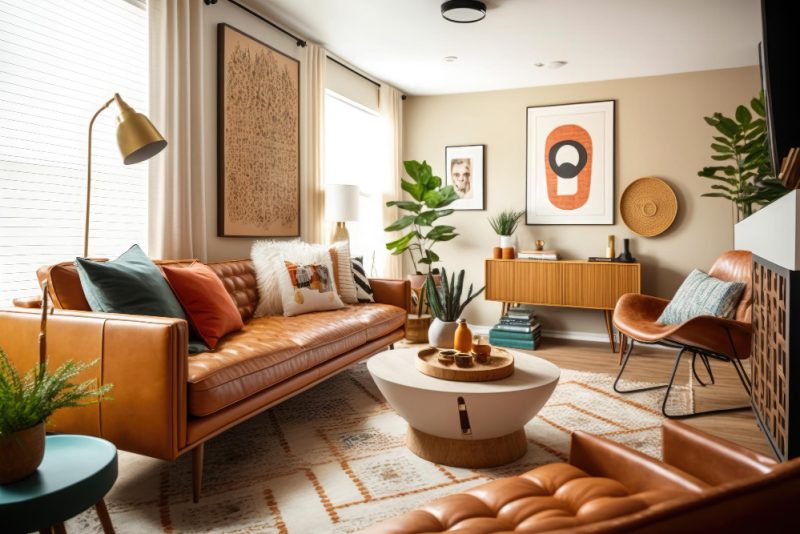Understanding the Space: The Starting Point for a Thoughtful Design
Arranging furniture in a small living room can feel like an intricate puzzle, where every piece must not only fit but also serve a purpose without overwhelming the space. The key to success lies in understanding the dimensions, the flow of movement, and how natural light interacts with the room.
Before placing a single item, it’s essential to step back and analyze the architecture: where are the windows? How does the door swing? Are there any built-in features like radiators, shelves, or beams that influence the layout?
These questions form the foundation for any thoughtful design, helping to avoid common mistakes such as overcrowding or blocking visual lines that make a room feel cramped.
A fundamental principle in small space design is to create a sense of openness and balance. This doesn’t necessarily mean pushing all furniture against the walls, as many might think. In fact, floating pieces—like a sofa or a pair of armchairs pulled slightly away from the wall—can enhance the sense of depth and prevent the room from feeling like a box.
Maintaining clear pathways—ideally at least 60 to 75 centimeters wide—between furniture allows for comfortable movement and ensures the space remains functional. It’s also vital to consider how each piece contributes to the overall harmony of the room, both aesthetically and practically.
The Art of Scaling: Choosing the Right Furniture for Small Spaces
Selecting furniture for a small living room requires a discerning eye. Oversized sofas or bulky armchairs, while appealing in a showroom, can dominate a compact space and create an oppressive atmosphere.
Opting for streamlined silhouettes with exposed legs—like a mid-century modern sofa or a Scandinavian-inspired armchair—introduces a sense of airiness. These designs allow the eye to travel underneath the furniture, preserving the feeling of openness. Similarly, coffee tables with glass tops or nesting tables can maximize functionality without visually cluttering the space.
Multi-functional pieces are a cornerstone of small space design. A storage ottoman that doubles as a coffee table, a compact loveseat with hidden compartments, or a sleek console that transforms into a dining surface can provide both utility and style. Avoiding excessive ornamentation and choosing pieces with clean lines and subtle textures also prevents the room from feeling visually noisy.
This doesn’t mean the space has to be minimalistic or devoid of personality. Instead, it’s about curating elements with intention, ensuring each addition enhances the space rather than simply filling it.
The Power of Zoning: Creating Purposeful Areas Within a Small Room
Even in the smallest living rooms, thoughtful zoning can define areas for different activities—relaxation, entertainment, or conversation—without erecting physical barriers. Rugs play an essential role in this process, helping to anchor furniture groupings and provide a visual boundary. A well-chosen rug, scaled appropriately to fit under the front legs of major pieces, can unify the seating area and prevent the room from feeling fragmented.
Lighting is another critical tool in creating zones and mood. In a small living room, relying solely on overhead lighting can create harsh shadows and a flat atmosphere. Layering different types of lighting—such as a floor lamp next to a reading chair, a table lamp on a side table, and a string of warm fairy lights near a window—adds dimension and creates cozy pockets of interest.
Mirrors can also play a transformative role: placed opposite a window, they bounce natural light and visually double the perceived space, making the room feel brighter and more expansive.
Personalizing the Space: The Finishing Touches
A small living room should never feel like a sterile box; it should reflect the personality and lifestyle of those who inhabit it. Artwork, decorative cushions, and thoughtfully chosen accessories inject warmth and character.
To prevent the room from feeling overcrowded, it’s wise to adopt a “less but better” philosophy: a single bold piece of art, a striking vase, or an heirloom object displayed prominently can often make a more powerful statement than multiple small items scattered throughout the space.
Speaking of vases, a delightful way to add personality and charm to a small living room is to take inspiration from the unique MGMaison collection of vases. These pieces not only add a sculptural element but also allow for seasonal changes—be it a single bloom in spring or a minimalist arrangement of branches in winter.
Carefully chosen, they can become a subtle yet impactful focal point.
Maximizing Storage Without Sacrificing Style
Storage is often a primary concern in a small living room, yet it needn’t come at the expense of aesthetics. Built-in shelves around a fireplace or TV unit, low-profile cabinets along a wall, or even a window seat with hidden compartments can provide valuable storage without crowding the floor space.
Open shelving, when styled with a mix of books, plants, and decorative objects, can add visual interest without feeling too heavy. The key is to maintain a sense of balance: avoid overfilling shelves, and leave space for negative space to let the eye rest.
Baskets, trays, and decorative boxes are also practical tools for organizing smaller items like remote controls, magazines, or throws. They help maintain an orderly appearance while allowing for easy access to essentials. By integrating storage solutions seamlessly into the design, the living room remains both beautiful and functional—a true reflection of intentional living.
Final Reflections: A Room That Grows With You
Ultimately, the best way to arrange furniture in a small living room is not a fixed formula, but a thoughtful, evolving process. It involves balancing function with beauty, openness with intimacy, and practicality with personal expression. By paying attention to the room’s proportions, choosing pieces wisely, and incorporating layered lighting and meaningful accessories, a small living room can transcend its size and become a space that feels inviting, harmonious, and uniquely yours.
Every choice, from the layout to the smallest detail, contributes to creating a space where life unfolds naturally—proof that even the most compact rooms can offer comfort, style, and joy in abundance.








